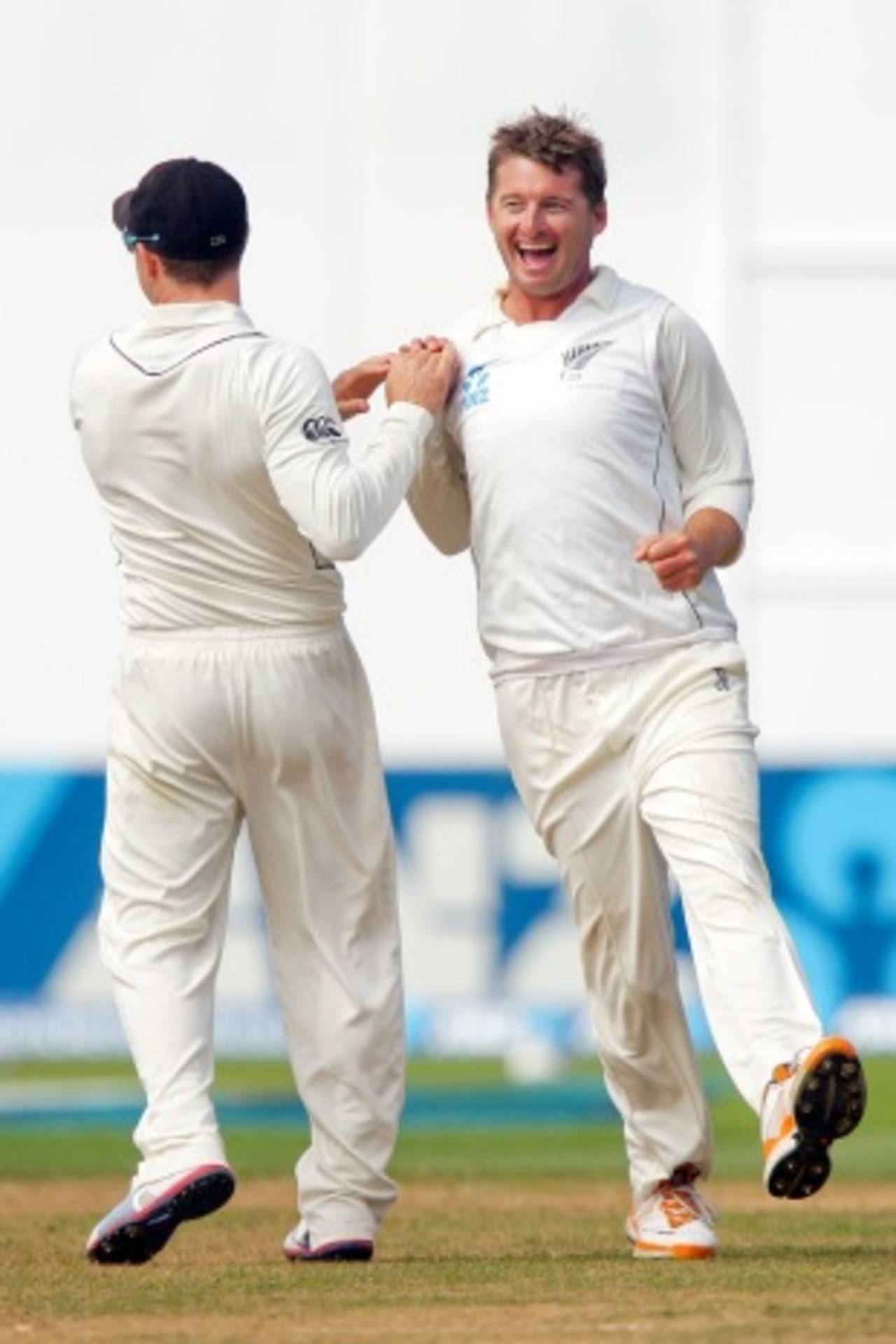New Zealand struggled in the second Test,
in Wellington, as England
reciprocated the hosts'
Dunedin dominance.
Taking wickets was a struggle and the first-innings batting was
flaky, yet there were encouraging signs.
Kane Williamson produced a promising rearguard batting
display in the second innings, Brendon McCullum and
BJ Watling
looked solid in the middle order, and
Bruce Martin spun together a
more confident performance as he adjusted to the Test game.
On the flip side:
Ross Taylor missed the chance to fully expunge
his unsettled Test form;
Peter Fulton looked vulnerable, edging
deliveries just outside off stump; and the pace attack lacked vim.
The opening two Tests have read like Agatha Christie whodunits
with the final chapter ripped out. The denouement in Auckland
could prove a lottery. It will be Eden Park's first time hosting a
Test in seven years. The ground has notorious short boundaries, but fingers crossed top edges won't be rewarded with sixes as happened
in the shorter forms. The drop-in pitch, crafted by well-regarded
groundsman Mark Perham, will hopefully offer more lateral movement
for seamers (at least on the opening day). Is this worth the risk for
New Zealand? You bet, especially with just
one home series victory in
17 attempts against England (1983-84).
Williamson shapes as a key component to New Zealand's third-Test
strategy. He brings a wholehearted straight-bat defence, a still head
at the point of delivery, and a clock face of shots. His second
-innings 55 not out in Wellington blunted England's pace attack, although he looked
vulnerable when Monty Panesar bowled into the footmarks.
Williamson's innings was a reminder of how he had eked out a draw (and an unbeaten
century) at the Basin against a South African attack including Dale
Steyn, Vernon Philander and Morne Morkel last year.
Critics will point to his average (31.86 in 22 Tests) not being sufficient to bat
at No. 3, but perseverance is required. After the same number of Tests,
Martin Crowe (who debuted at 19, compared to Williamson's 20)
averaged 31.60. Williamson can further move from "promising player"
to "world-class No. 3" with another strong performance against a
reputable attack.
His courage was reinforced by the century sixth-wicket
stand between McCullum (69) and Watling (60) in the first innings.
The pair have the ability to make an old ball look every bit its age
, and with pasts as openers, they're not daunted by the second new
ball.
Watling's batting and wicketkeeping look to have secured him a tour spot to
England, despite the form of Wellington's Luke Ronchi (who could
well join the tour). Watling has been one of the
few to return from South Africa with his cricketing reputation
intact.
McCullum led by example, combining batting with his captaincy
duties,
scoring between 69 and 79 six times in the series so far. If there's a minor quibble, he
might need to look at his Test century conversion rate (18% - six out of 33). Compare that to Ross Taylor (32%
- eight out of 25).
However, Taylor has struggled in his Test
return, despite a couple of Plunket Shield half-centuries leading in.
He has looked tentative early, and suffered the misfortune of
receiving a top-of-off-stump delivery from Stuart Broad to be dismissed for a golden duck in Wellington. The Test petered out with Taylor
41 not out in the second innings, looking on the cusp of regaining
form.
Fulton made a useful second-innings 45 but was dismissed in both
innings doling catches to first slip with limited footwork. The
English bowlers will be salivating. Still, scores of 55, 1 and 45
have justified his selection
so far, after more than three years' domestic toil.
New Zealand's biggest concern is the lack of pace penetration. It's
the fourth consecutive Test in which the side has failed to take 20 wickets. Spearhead
Tim Southee has returned from a thumb injury but his
series return of one wicket for 216 runs from 83 overs is a concern.
He has struggled to generate his usual late swing, and with little
seam movement from benign pitches, it has weakened the New Zealand
attack. None of the trio, which includes Trent Boult and Neil Wagner,
lacked heart but England struck few problems on their way to 465.
Doug Bracewell could bolster the starting
XI in Auckland after recovering from his cut foot, but it would seem more like a
punt than clear strategy. Since South Africa arrived a year ago, he
has taken
25 wickets at 44.84 in 11 Tests. Wagner was the best bowler in Dunedin
, with seven wickets, while Southee and Boult deserve further opportunities
in recognition of past form.
Martin is the feel-good story of the attack. The left-arm orthodox
bowler was essentially selected as a stop-gap in Daniel
Vettori's absence but has done enough in two Tests with nine wickets
at 29.22 (combined with 62 sturdy runs in the lower order) to suggest
he is a worthy candidate to tour England. While his Dunedin first-
innings haul of 4 for 43 might - Jonathan Trott excepted - be
referred to as "mopping up the tail", he came right with his
flight and guile in the second Test.
Taking the ball away from England's six right-hand batsmen in
the top seven, Martin dismissed century-maker Nick Compton, Kevin
Pietersen, Ian Bell and Joe Root. His first wicket came at 236 for
1, so England had earned the right to play with some licence, but
that was hardly Martin's fault. A lack of strike power and a tame pitch
were complicit.
Andrew Alderson is cricket writer at New Zealand's Herald on Sunday
